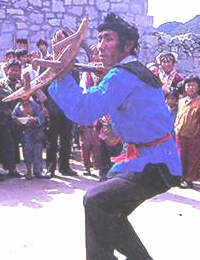 The 437,997 (as of 1999) Gelos live in dispersed clusters of communities in about 20 counties in western Guizhou Province, four counties of the Wenshan Zhuang-Miao Autonomous Prefecture in southeastern Yunnan Province and the Longlin Multi-ethnic Autonomous County in Guangxi Zhuang Autonomous Region.
The 437,997 (as of 1999) Gelos live in dispersed clusters of communities in about 20 counties in western Guizhou Province, four counties of the Wenshan Zhuang-Miao Autonomous Prefecture in southeastern Yunnan Province and the Longlin Multi-ethnic Autonomous County in Guangxi Zhuang Autonomous Region.
The Gelo language, consisting of four dialects, belongs to the Zhuang-Dong Austronesian of the Chinese-Tibetan Phylum. Now, only a quarter of the Gelos still speak this language. The four dialects differ so greatly from each other that even Gelos in the same county have difficulty in communicating with each other. For this reason, the language of the Hans, or Chinese, has become their common language. Also, the languages of the Miao, Yi and Bouyei are also used by the Gelo. The Gelos have no alphabet of their own, so they use Chinese characters for their script.
Over the last 2,000 years or more, Gelos have lived in many places in China. Bridges, graves, wells, and even villages in Guizhou Province still bear Gelo names. The ethnic minority's name dates back to the Ming Dynasty (1368-1644). Before then, they were called the "Liaos". Descended from the Yelang, the strongest tribe in the Han Dynasty's Zangke Prefecture, the Liaos moved out of Zangke to Sichuan and many other places.
The Gelo people are mainly engaged in agriculture. Main crops include maize, paddy, wheat, potato, etc. Other occupations include manufacturing, herb collecting and animal husbandry. Iron forging is well developed.
They are polytheists and ancestor worshippers. Gelo folk literature consists of poetry, stories and proverbs. Gelo dances are simple and graceful, accompanied by theerhu, horizontalxiao,suona,gong, drumand other string and wind instruments.
Most Gelo festivals echo Han traditions, but some practices differ. At Spring Festival -- the Lunar New Year -- Gelos offer a huge rice cake to their ancestors and after it is made, it remains untouched for three days. On the first day of the tenth lunar month, Gelos give their oxen a day of rest. This is the day of the Ox King Buddha, and in some communities on this day oxen are honored and fed special rice cakes.
The Gelo people also celebrate their Tree Worshipping Festival on August 15 of the lunar calendar. The most important activity of this festival is offering sacrifices to the holy tree. During this ceremony, all the men of the villages walk around the nearby mountain slopes. Then they offer sacrifice to the holy tree and pray to their god for happiness and a good harvest in the following year.
